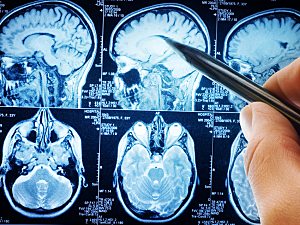In 2023, a Brigham and Women’s Hospital team published evidence in Nature Human Behaviour that six psychiatric disorders map to a common brain network. The results suggested neuromodulation targets for patients who have more than one disorder.
Now, the researchers have found that multiple substance use disorders map to their own common brain network, a finding that has therapeutic implications of its own. Jacob L. Stubbs, PhD, formerly a visiting scholar at the Center for Brain Circuit Therapeutics at Brigham and Women’s Hospital, Michael D. Fox, MD, PhD, director of the Center and Kaye Family director of the Psychiatric Brain Stimulation Program, and colleagues report in Nature Mental Health.
Atrophy Coordinate Network
The team started by investigating neural coordinates of atrophy, often considered a late manifestation of chronic substance use (although addiction can occur in the absence of atrophy). The first dataset was drawn from a Translational Psychiatry meta-analysis of 45 studies across 3,791 participants.
The primary substance use disorder investigated in each study was alcohol (n=12 studies), nicotine (n=11), cocaine (n=9), opioids (n=7), cannabis (n=1), stimulants (n=1), or ketamine (n=1). The three other studies included participants who used multiple substances. Co-use of alcohol and nicotine may have been present in many of the other studies, but it was not always explicitly stated.
91% of the coordinates studied shared connectivity to a common brain network, and the consistency of the connectivity pattern across studies was greater than would be expected by chance. The network was distinct from coordinates of atrophy associated with aging and/or neurodegeneration.
fMRI Coordinate Network
Early substance abuse is often thought to be due to neural reorganization, which might be detected on functional MRI before (or instead of) substance use manifests as atrophy. The team examined whether the atrophy coordinate network aligned with networks derived from neuroimaging findings across substance use disorders.
A meta-analysis published in Human Brain Mapping provided data from 99 studies across 5,256 participants. The primary substance use disorders studied were alcohol (n=31), cocaine (n=25), cannabis (n=25) and nicotine (n=18).
80% of the coordinates of fMRI abnormalities shared connectivity to a common brain network. As before, the consistency of the connectivity was greater than expected by chance. Neither the atrophy coordinate network map nor the fMRI map was driven by any single substance.
Overall Coordinate Network
The researchers combined all the data (144 studies; 9,047 participants) into a single coordinate network map. The network connected positively with the anterior cingulate, bilateral insulae, bilateral dorsolateral prefrontal cortices and thalamus. These regions have been implicated in processes related to substance use disorders, including craving, incentive salience, emotion and risky decision-making.
The network connected negatively to the medial prefrontal and occipital cortices, among other regions.
Finally, the team tested whether brain lesions causally related to substance use disorders were associated with more damage to the overall coordinate network than lesions that did not disrupt substance use disorders. As background, some stroke survivors experience remission of nicotine addiction—they immediately quit smoking without difficulty and don’t relapse.
In a previous study, published in Nature Medicine, the Brigham team performed lesion network mapping and showed that lesions associated with nicotine addiction remission were characterized by a specific pattern of brain connectivity:
- Positive connectivity to the dorsal cingulate, lateral prefrontal cortex, and insula
- Negative connectivity to the medial prefrontal and temporal cortex
The current study showed that 34 stroke lesions that cause remission from nicotine use disorder caused significantly more damage to the overall coordinate network than 69 lesions not associated with remission (P<0.0084).
Implications for Neuromodulation
In theory, the negative nodes in the overall network should be ideal locations for excitatory brain stimulation, such as transcranial magnetic stimulation (TMS). It’s exciting that the overall coordinate network and the nicotine addiction remission network share negative connectivity to the medial prefrontal/frontopolar cortex.
That region of the brain overlaps with the maximal electric field of two existing TMS coils—one recently approved by the FDA for treatment of nicotine use disorder and one shown to be effective for alcohol use disorder. The efficacy of coils that target that region for two different substance use disorders provides support for the potential therapeutic relevance of the newly identified network.
